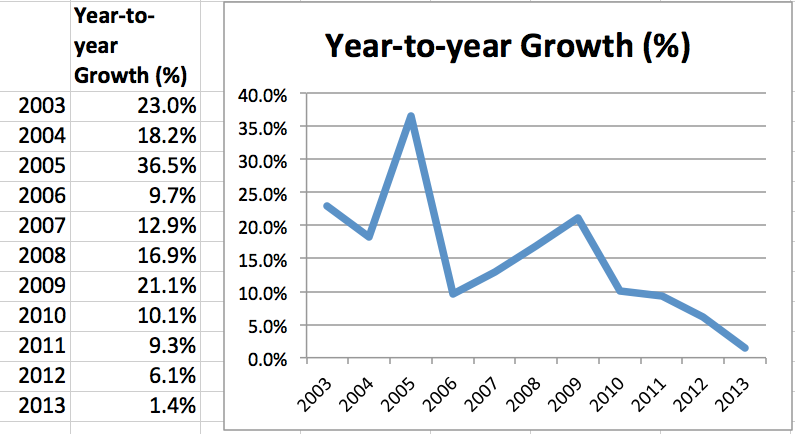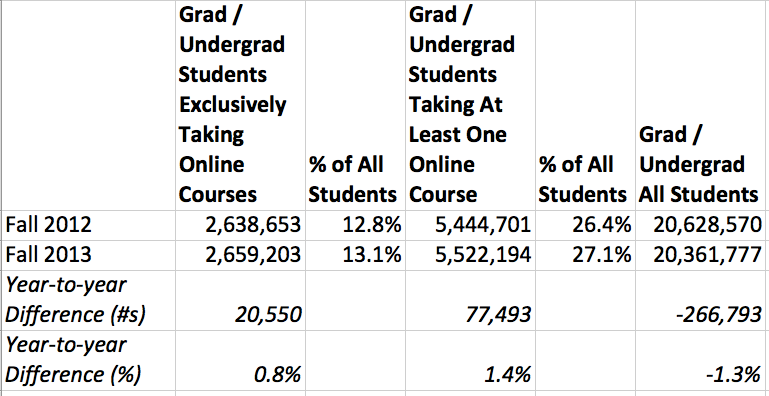By 2015, 25 million post-secondary students in the United States will be taking classes online. And as that happens, the number of students who take classes exclusively on physical campuses will plummet, from 14.4 million in 2010 to just 4.1 million five years later, according to a new forecast released by market research firm Ambient Insight.
On the positive side, Moody’s notes that the U.S. Department of Education projects a 20-percent growth in master’s degrees and a 9-percent growth in associate degrees, opportunities in both online education and new certificate programs, and a rising earnings premium for those with college degrees.
– Chronicle of Higher Ed, 2014
Q. How likely would it be that this fraction [% students taking online courses] would grow to become a majority of students over the next five years? A [from institutional academic leaders]. Nearly two-thirds responded that this was “Very likely,” with an additional one-quarter calling it “Likely.” [That’s almost 90% combined]
– Grade Change, Babson Survey 2013
More than two-thirds of instructors (68 percent) say their institutions are planning to expand their online offerings, but they are split on whether or not this is a good idea (36 percent positive, 38 percent negative, 26 percent neutral).
Still, the [disruptive innovation] theory predicts that, be it steam or online education, existing consumers will ultimately adopt the disruption, and a host of struggling colleges and universities — the bottom 25 percent of every tier, we predict — will disappear or merge in the next 10 to 15 years.
You could be forgiven for assuming that the continued growth of online education within US higher ed was a foregone conclusion. We all know it’s happening; the questions is how to adapt to the new world.
But what if the assumption is wrong? Based on the official Department of Education / NCES new IPEDS data for Fall 2013 term, for the first time there has been no discernible growth in postsecondary students taking at least one online course in the US.
From 2002 through 2013 the most reliable measure of this metric has been the Babson Survey Research Group (BSRG) annual reporting. While there are questions on absolute numbers due to questions on definition of what makes a course “online”, the year-over-year growth numbers have been quite reliable and are the most-referenced numbers available. Starting last year, using Fall 2012 data, the official IPEDS data started tracking online education, and last week they put out Fall 2013 data – allowing year-over-year changes.
I shared the recent overall IPEDS data in this post, noting the following:
By way of comparison, it is worth noting the similarities to the Fall 2012 data. The percentage data (e.g. percent of a sector taking exclusive / some / no DE courses) has not changed by more than 1% (rounded) in any of the data. This unfortunately makes the problems with IPEDS data validity all the more important.
It will be very interesting to see the Babson Survey Research Group data that is typically released in January. While Babson relies on voluntary survey data, as opposed to mandatory federal data reporting for IPEDS, their report should have better longitudinal validity. If this IPEDS data holds up, then I would expect the biggest story for this year’s Babson report to be the first year of no significant growth in online education since the survey started 15 years ago.
I subsequently found out that BSRG is moving this year to use the IPEDS data for online enrollment. So we already have the best data available, and there is no discernible growth. Nationwide there are just 77,493 more students taking at least one online class, a 1.4% increase.
Why The Phrase “No Discernible Growth”?
Even though there was a nationwide increase of 77,493 students taking at least one online course, representing a 1.4% growth, there is too much noise in the data for this to be considered real growth. Even with the drop in total enrollment, the percentage of students taking at least one online course only changed from 26.4% TO 27.1%.
Just take one school – Suffolk County Community College – who increased by roughly 21,600 student enrollments taking at least one online course from 2012 to 2013 due to a change in how they report data and not from actual enrollment increases. More than a quarter of the annual nationwide increase can be attributed to this one reporting change1. These and similar issues are why I use the phrase “no discernible growth” – the year-over-year changes are now lower than the ability of our data collection methods to accurately measure.
Combine Babson and IPEDS Growth Data
While we should not directly compare absolute numbers, it is reasonable to combine the BSRG year-over-year historical growth data (2003 – 2012) with the new IPEDS data (2012 – 2013).

One thing to notice is that is really a long-term trend of declining growth in online. With the release of last year’s BSRG report they specifically called out this trend.
The number of additional students taking at least one online course continued to grow at a rate far in excess of overall enrollments, but the rate was the lowest in a decade.
What has not been acknowledged or fully understood is the significance of this rate hitting zero, at least within the bounds of the noise in data collection.
Implications
Think of the implications here if online education has stopped growing in US higher education. Many of the assumptions underlying institutional strategic plans and ed tech vendor market data is based on continued growth in online learning. It is possible that there will be market changes leading back to year-over-year growth, but for now the assumptions might be wrong.
Rather than focusing just on this year, the more relevant questions are based on the future, particularly if you look at the longer-term trends. Have we hit a plateau in terms of the natural level of online enrollment? Will the trend continue to the point of online enrollments actually dropping below the overall enrollment? Will online enrollments bottom out and start to rise again once we get the newer generation of tools and pedagogical approaches such as personalized learning or competency-based education beyond pilot programs?
I am not one to discount the powerful effect that online education has had and will continue to have in the US, but the growth appears to be at specific schools rather than broad-based increases across sectors. Southern New Hampshire, Arizona State University, Grand Canyon University and others are growing their online enrollments, but University of Phoenix, DeVry University and others are dropping.
One issue to track is the general shift from for-profit enrollment to not-for-profit enrollment, even if the overall rates of online courses has remained relatively stable within each sector. There are approximately 80,000 fewer students taking at least one online course at for-profit institutions while there are approximately 157,000 more students in the same category at public and private not-for-profit sectors.
I suspect the changes will continue to happen in specific areas – number of working adults taking courses, often in competency-based programs, at specific schools and statewide systems with aggressive plans – but it also appears that just making assumptions of broad-based growth needs to be reconsidered.
Update: Please note that the data release is new and these are early results. If I find mistakes in the data or analysis that changes the analysis above, I’ll share in an updated post.
- Russ Poulin and I documented these issues in a separate post showing the noise is likely in the low hundreds of thousands. [↩]

[…] By 2015, 25 million post-secondary students in the United States will be taking classes online. And as that happens, the number of students who take classes exclusively on physical campuses will plummet, from 14.4 million in 2010 to just 4.1 … Continue reading → […]